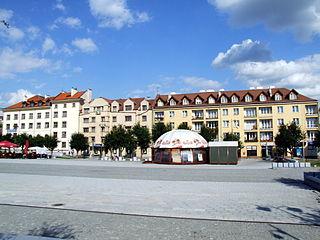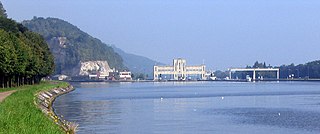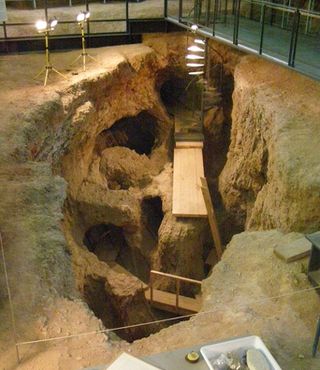Related Research Articles

Flint, occasionally flintstone, is a sedimentary cryptocrystalline form of the mineral quartz, categorized as the variety of chert that occurs in chalk or marly limestone. Historically, flint was widely used to make stone tools and start fires.

Świętokrzyskie Voivodeship, also known as Holy Cross Voivodeship, is a voivodeship (province) in southeastern Poland, in the historical region of Lesser Poland. The province's capital and largest city is Kielce.

Ostrowiec Świętokrzyski, often referred to as Ostrowiec, is a city in southeastern Poland, in the historical region of Lesser Poland, with 66,258 residents. The town is one of the historic centers of Polish industry and metallurgy, and was part of the Old-Polish Industrial Region, the oldest industrial basin of the country.

The Langdale axe industry is the name given by archaeologists to a Neolithic centre of specialised stone tool production in the Great Langdale area of the English Lake District. The existence of the site, which dates from around 4,000–3,500 BC, was suggested by chance discoveries in the 1930s. More systematic investigations were undertaken by Clare Fell and others in the 1940s and 1950s, since when several field surveys of varying scope have been carried out.

Grime's Graves is a large Neolithic flint mining complex in Norfolk, England. It lies 8 km (5.0 mi) north east from Brandon, Suffolk in the East of England. It was worked between c. 2600 and c. 2300 BCE, although production may have continued through the Bronze and Iron Ages and later, owing to the low cost of flint compared with metals. Flint was much in demand for making polished stone axes in the Neolithic period. Much later, when flint had been replaced by metal tools, flint nodules were in demand for other uses, such as for building and as strikers for muskets.
The mining industry in India is a major economic activity which contributes significantly to the economy of India. The gross domestic product (GDP) contribution of the mining industry varies from 2.2% to 2.5% only but going by the GDP of the total industrial sector, it contributes around 10% to 11%. Even mining done on small scale contributes 6% to the entire cost of mineral production. Indian mining industry provides job opportunities to around 700,000 individuals.
The prehistory of the County of Norfolk, England is broken into specific time periods, these being Palaeolithic, Mesolithic and Neolithic.

Rădăuți-Prut is a commune in Botoșani County, Western Moldavia, Romania, composed of three villages: Miorcani, Rădăuți-Prut and Rediu. It was seriously affected by floods in July 2008.

The Do-Ashkaft Cave, being a Middle Paleolithic cave site, is located north of Kermanshah, near Taq-e Bostan, Iran about 1,600 m (5,200 ft) above sea level. Its entrance faces south of Meywala Mount, overlooking the national park of Kuhestan. The site was first visited in 1996 by Iranian researchers F. Biglari and S. Heydari-Guran and during the following four years a series of surface surveys were made at one-month intervals, which resulted in a rich collection of Middle Paleolithic lithic artifacts.
The Stone Age in the territory of present-day Poland is divided into the Paleolithic, Mesolithic, and Neolithic eras. The Paleolithic extended from about 500,000 BCE to 8000 BCE. The Paleolithic is subdivided into periods, the Lower Paleolithic, 500,000 to 350,000 BCE, the Middle Paleolithic, 350,000 to 40,000 BCE, the Upper Paleolithic, 40,000 to 10,000 BCE, and the Final Paleolithic, 10,000 to 8000 BCE. The Mesolithic lasted from 8000 to 5500 BCE, and the Neolithic from 5500 to 2300 BCE. The Neolithic is subdivided into the Neolithic proper, 5500 to 2900 BCE, and the Copper Age, 2900 to 2300 BCE.
Piatra Tomii is a late Jurassic limestone outcrop forming a small hill near Răcătau village, Alba county, Romania. It is most well known for the Chalcolithic to Bronze Age flint mining settlement located on and near to the hill. The settlement is late Chalcolithic to Early Bronze Age. The people who occupied this site belonged to the Coțofeni culture. The chief investigator of this archaeological site is Cristian Popa of the 1 Decembrie 1918 University, Alba Iulia. The artefact collection from this site are housed at the university in Alba Iulia. This site is significant as it is the first flint mine or quarry found so far in the Transylvanian basin. Petrographic analysis of the flint materials found at this site link it to artifacts found at prehistoric sites from throughout the Mures Valley leading researchers to believe that this site may have served an important role in the commerce of the Chalcolithic and Bronze Age. The large size of the settlement compared to its relative isolation high in the Apuseni Mountains tends to support this theory.

Mount Saint Peter, also referred to as Caestert Plateau, is the northern part of a plateau running north to south between the valleys of the river Geer to the west, and the Meuse to the east. The plateau runs from Maastricht in the Netherlands, through Riemst in Belgian Limburg almost to the city of Liège in Belgium, thus defining the topography of this border area between Flanders, Wallonia and the Netherlands. The name of the hill, as well as the nearby village and church of Sint Pieter and the fortress of Sint Pieter, refers to Saint Peter, one of the Twelve Apostles.

Krzemionki, also Krzemionki Opatowskie, is a Neolithic and early Bronze Age complex of flint mines for the extraction of Upper Jurassic (Oxfordian) banded flints located about eight kilometers north-east of the Polish city of Ostrowiec Świętokrzyski. It is one of the largest known complexes of prehistoric flint mines in Europe together with Grime's Graves in England and Spiennes in Belgium.
Avi Gopher is an Israeli archaeologist. He is a professor at the University of Tel Aviv.
Gerd Weisgerber was an eminent German professor of mining archaeology. He was one of the first mining archaeologists of the world, who set standards in this scientific discipline. As a scientist from the German Mining Museum, he focused his research mainly on Western Asia, especially on Oman, Jordan, Palestine, and Iran.

The Neolithic flint mines of Spiennes are among the largest and earliest Neolithic flint mines which survive in north-western Europe, located close to the Walloon village of Spiennes, southeast of Mons, Belgium. The mines were active during the mid and late Neolithic between 4,300 and 2,200 BC. Declared to be "remarkable for the diversity of technological solutions used for extraction" the site and its surroundings were inducted into the UNESCO's list of World Heritage Sites in 2000.
Miles Russell, is a British archaeologist best known for his work and publications on the prehistoric and Roman periods and for his appearances in television programmes such as Time Team and Harry Hill's TV Burp.

Lizq is an archaeological site in Ash Sharqiyah, Oman. Located on a mountain lying in a plain, 1000 m south-east of the south-eastern edge of the Lizq palm garden, the fort dates to the Lizq-Rumaylah/Early Iron Age.

The Emilianstollen is part of a Roman copper mine on the escarpment of the Saargau in the St. Barbara district of Wallerfangen in Saarland, Germany.

The Gavà Mines, also known as Can Tintorer Mines, is a pre-historic (Neolithic) archaeological site that occupies the Can Tintorer, Ferreres and Rocabruna areas in the municipality of Gavà. The site is under care of the Gavà Museum and the Gavà Mines Archaeological Park.
References
- ↑ Mindo S.A. "Mindo S.A. Annual Report" (PDF). Retrieved 14 May 2012.[ permanent dead link ]
- ↑ Verri, G. (17 May 2004). "Flint mining in prehistory recorded by in situ-produced cosmogenic 10Be". Proceedings of the National Academy of Sciences. 101 (21): 7880–7884. Bibcode:2004PNAS..101.7880V. doi: 10.1073/pnas.0402302101 . PMC 419525 . PMID 15148365.
- ↑ Bostyn, F. and Lanchon, Y. (eds.) (1992). Jablines. Le Haut Château (Seine-et-Marne). Une minière de silex au Néolithique. Paris: Editions de la Maison des Sciences de L’Homme: Documents d’Archéologie Française, 35.
{{cite book}}:|last=has generic name (help)CS1 maint: multiple names: authors list (link) - ↑ Bostyn, F.; Lanchon, Y. (1997). "The Neolithic Flint Mine at Jablines, 'Le Haut Château' (Seine-et-Marne)". In A. Ramos-Millán; M.A. Bustillo (eds.). Siliceous rocks and culture. Granada: Universidad de Granada. pp. 271–291. ISBN 9788433823908.
- ↑ Barber, M., Field, D. and Topping, P. (1999). The Neolithic Flint Mines of England. Swindon: English Heritage.
{{cite book}}: CS1 maint: multiple names: authors list (link) - ↑ Holgate, R. (1995). "Neolithic flint mining in Britain". Archaeologia Polona. 33: 133–161.
- ↑ Topping, P. (1997). Structured deposition, symbolism, and the English flint mines. In R. Schild and Z. Sulgostowska (eds), Man and Flint. Proceedings of the VIIth International Flint Symposium. Warszawa-Ostrowiec Świętokrzyski, Warszawa. Warsaw: Institute of Archaeology and Ethnology Polish Academy of Sciences. pp. 127–131.
- ↑ "The Rohri Flint Quarries; Bibliography". Archived from the original on 6 January 2013. Retrieved 14 May 2012.
- ↑ Migal, W.; Salacinski, S. (1997). Studies at Krzemionki during the last decade. In R. Schild and Z. Sulgostowska, Man and Flint. Proceedings of the VIIth International Flint Symposium. Warszawa-Ostrowiec Świętokrzyski. Warsaw: Institute of Archaeology and Ethnology. Polish Academy of Sciences. pp. 103–108.
- ↑ Lech, H.; Lech, J. (1984). "The Prehistoric Flint Mine at Wierzbica 'Zele': A Case Study from Poland". World Archaeology. 16 (2): 186–203. doi:10.1080/00438243.1984.9979927.
- ↑ Osipowicz, G., Kerneder-Gubała, K., Bosiak, M., Makowiecki, D., Orłowska, J. (April 2019). "The oldest osseous mining tools in Europe? New discoveries from the chocolate flint mine in Orońsko, site 2 (southern Poland)". Quaternary International. 512: 82–98. doi:10.1016/j.quaint.2019.02.005. ISSN 1040-6182.
- ↑ Kerneder-Gubała, K., Buławka, N., Buławka, S., Szubski, M. (2017). "GIS w badaniach powierzchniowych stanowisk górniczych na przykładzie kopalni krzemienia czekoladowego w Orońsku (gm. Orońsko, pow. Szydłowiecki, woj. Mazowieckie)". Archeologia Polski. LXII: 7–37.
- ↑ http://www.casamontero.org/.
{{cite web}}: Missing or empty|title=(help) - ↑ Allard P.; et al. (2008). Flint mining in prehistoric Europe : interpreting the archaeological records : European Association of Archaeologists, 12th annual meeting, Cracow, Poland, 19th-24th September 2006. Oxford: Archaeopress. ISBN 9781407303710.
- ↑ Aubry, Thierry; Mangado Llach, Javier (2006). The Côa valley (Portugal) : lithic raw material characterisation and the reconstruction of Upper Palaeolithic settlement patterns. In: Notions de territoire et de mobilité : exemples de l'Europe et des premières nations en Amérique du Nord avant le contact européen : actes des sessions présentées au Xe congrès annuel de l'Association européenne des Archéologues (EAA), Lyon, 8–11 sept. pp. 41–49.
- ↑ Hunt Ortiz, M.A. (1996). La explotación de los recursos minerales en Europa y la Península Ibérica durante la prehistoria. Universidad de Valladolid.
- ↑ Matías Rodríguez, R. (2005). "Origen de la minería". Cimbra. 362.
- ↑ Weisgerber G, Slotta R (1999). 5000 Jahre Feuersteinbergbau : die Suche nach dem Stahl der Steinzeit ; Ausstellung im Deutschen Bergbau-Museum Bochum vom 24. Oktober 1980 bis 31. Januar 1981 (3., verb., erw. u. aktualisierte Aufl. ed.). Bochum: Deutsches Bergbau-Museum. ISBN 9783921533666.